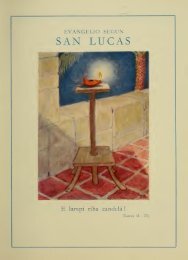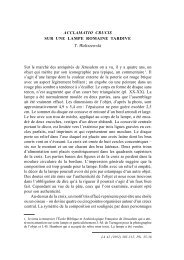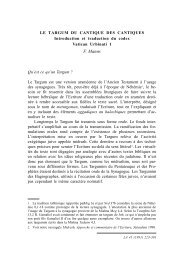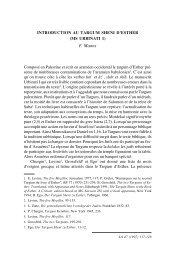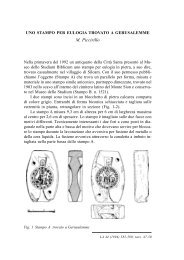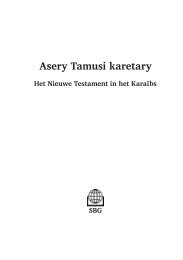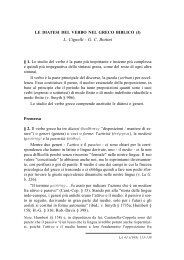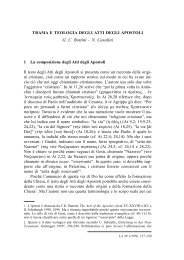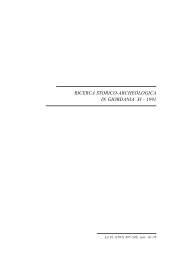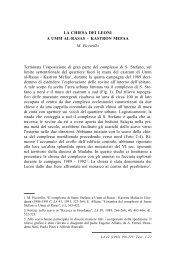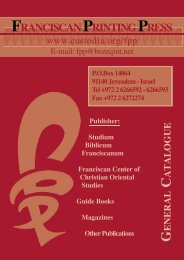Literary Criticism and Theology of P - Christus Rex
Literary Criticism and Theology of P - Christus Rex
Literary Criticism and Theology of P - Christus Rex
You also want an ePaper? Increase the reach of your titles
YUMPU automatically turns print PDFs into web optimized ePapers that Google loves.
10<br />
E. CORTESE<br />
This reductionist trend reaches its most radical position in Th. Pola 6 .<br />
He attributes to Pg the usual (<strong>and</strong> classical) portion <strong>of</strong> texts up to Ex 25.<br />
But from Ex 25 onwards his Pg is limited only to 25,1.8a.9; 29,45f. <strong>and</strong><br />
40,16.17a.33b <strong>and</strong> nothing more either in Lev or in Num 7 . The consequences<br />
<strong>of</strong> this reductionist approach to the theology <strong>of</strong> P are obvious.<br />
Such a radicalism invites a more reasonable literary critical approach<br />
towards our texts. At the same time we do not follow here the opposite<br />
trend, which renounces literary criticism, by adopting other exegetical<br />
methods, not to mention fundamentalism.<br />
Now if one gives credit to literary criticism, as we do, one can hardly<br />
accept the proposed structures <strong>of</strong> tent sections <strong>of</strong> P, either in their entirety<br />
or in their parts, if such opinions are proposed without a previous literary<br />
criticism. Such schemes or structures could be proposed only for the end<br />
text, <strong>and</strong> are the product <strong>of</strong> later redaction (Ps) or the result <strong>of</strong> the final<br />
redaction. Therefore many <strong>of</strong> the proposed structures <strong>of</strong> Pg on the Sinai<br />
corpus are to be suspected.<br />
Those structures <strong>of</strong> Pg, which do not presume a prior literary criticism<br />
<strong>and</strong> which are based simply on the supposed parallelism with ANET<br />
accounts <strong>of</strong> temple building <strong>and</strong> on the bipolarism between prescriptive <strong>and</strong><br />
descriptive texts <strong>of</strong> the ancient documents <strong>and</strong> between comm<strong>and</strong> (Ex 25-<br />
31) <strong>and</strong> execution (35-41) 8 , are not acceptable to us. Nor do we agree with<br />
those who build their demonstration <strong>of</strong> the structure purely on literary or<br />
stylistic elements 9 .<br />
There is also a sort <strong>of</strong> structure like the one proposed by Janowski 10<br />
following Weimar, which is based on literary criticism, but presumes that<br />
6. Die ursprüngliche Priesterschrift. Beobachtungen zur Literarkritik und Traditionsgeschichte<br />
von Pg (WMANT 70), Neukirchen 1995.<br />
7. See for instance Pola, Die ursprüngliche Priesterschrift, 343, note 144.<br />
8. B. Levine, “The descriptive Tabernacle texts <strong>of</strong> the Pentateuch”, JAOS 85 (1965) 110-<br />
132. 307-318, has still his followers today.<br />
9. G. Steins, “Sie sollen mir ein Heiligtum machen. Zur Struktur und Entstehung von Ex<br />
24,12 (sic!)-31,18”, in F.L. Hossfeld (Ed.), Vom Sinai zu Horeb. Stationen alt. Glaubensgeschichte,<br />
Würzburg 1989, 145-167. The proposed structure is based principally on the<br />
speech introductions 30,11.17.22.34; 31,1.12, which are irregularly distributed in the<br />
complex. Moreover Steins admits the secondary trait, not only <strong>of</strong> Ex 30f., which the<br />
majority recognizes, but also <strong>of</strong> (28 <strong>and</strong>) 29, which he defends.<br />
10. B. Janowski, “Tempel und Schöpfung. Schöpfungstheologische Aspekte der priesterschr.en<br />
Heiligtum Konzeption”, JBT 5 (1990) 50 (now in Id., Gottesgegenwart in Israel.<br />
Beiträge zur Theologie des AT, Neukirchen 1993, 214-246).




